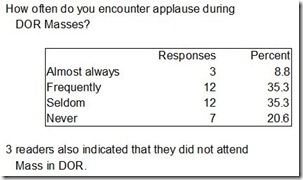The Philanthropy Roundtable has just released Saving America's Urban Catholic Schools: A Guide for Donors. As the title indicates, the book is targeted at potential donors and it makes the case for supporting Catholic schools in general and urban Catholic schools in particular.
Part of making that case involves detailing the success stories already out there and one of these stories involves the Diocese of Memphis.
In one five-year period, from 1999 to 2004, "donors helped the Diocese of Memphis reopen a total of nine previously shuttered inner-city Catholic schools. Supporters of the effort regularly refer to it as the 'Memphis Miracle.'"
There is absolutely no financial reason why this success story could not be repeated here. There is no shortage of well-heeled philanthropists in this area and the recently reported 46% graduation rate from our city's public high schools only serves to underline the need for quality alternatives to the Rochester city school system.
There is, however, one critical stumbling block that needs to be overcome and it will be, God willing, come 2012 (see the last sentence, below).
A free PDF version of the book is available here. The section on the Diocese of Memphis follows ...
Resurrecting Closed Schools: Miracle in Memphis
When all these elements come together—re-setting high academic standards, improving business practices, and increasing transparency and accountability—the end-result of a turnaround effort can be impressive. Perhaps the largest and most consequential turnaround effort to date has taken place in Memphis, Tennessee. Between 1999 and 2004, donors—both Catholic and non-Catholic—helped the Diocese of Memphis reopen a total of nine previously shuttered inner-city Catholic schools. Supporters of the effort regularly refer to it as the “Memphis Miracle.”
The effort started in July 1999. Bishop J. Terry Steib asked Mary C. McDonald, superintendent of schools, to develop and implement an ambitious strategic plan. The goal: to reopen nine shuttered Catholic schools in inner-city Memphis, some of which had been closed for over 50 years. As McDonald worked on the plan, she devised a new governance and infrastructure model, one that called for the closed parish schools located in the inner city to be reopened as diocesan schools. Under the new arrangement, the superintendent would serve as the chief executive officer of each school, with the principal acting as the chief operating officer. Pastors would continue to provide spiritual leadership, overseeing the Catholic identity and ongoing spiritual formation of teachers.
Once the plan was sufficiently developed,McDonald approached members of the business and philanthropic communities to interest potential investors. The effort was kicked off with an initial $10 million anonymous donation. All that was known was that the benefactor was not Catholic. An additional $5 million was raised from other interested donors. After receiving the initial funding of $15 million for renovation and scholarships, the program started with one school in August 1999.
Over the next four years, with additional funding in place, the Jubilee Catholic Schools— named for the Year of Jubilee proclaimed by Pope John Paul II in 2000—grew from that one to nine schools. All of the schools serve a student population whose families are at or below poverty level.
In 2003, the Jubilee initiative launched the Catholic Memphis Urban Schools Trust (CMUST) to assume responsibility of the financial oversight and budgets, as well as assist in ongoing development efforts. CMUST, according to McDonald, provides tuition assistance to families on a sliding scale, and helps the nine schools cover any operational deficits. It has its own, separate 501(c)(3) status, which was necessary to assure all investors that their contributions to the Jubilee schools were completely segregated from diocesan funds. Building an intermediary organization allows an expert, independent board to oversee fiscal management, reducing overhead and protecting funds from lawsuits that may be filed against the church.
In Memphis, oversight for the ongoing operations component remains in the superintendent’s office. Oversight for the financial component, meanwhile, resides with CMUST. To further ensure accountability, the program sought and received district accreditation in 2006 through the Southern Association of Colleges and Schools. This holds the academic program to a higher standard of third-party accountability, and ensures the continuous improvement of a quality academic program. Memphis was only the second diocese in the country to receive this accreditation.
The results have been, as some donors put it, miraculous. Enrollment continues to climb (please see Figure 6), and test scores are steadily improving.

The Hyde Family Foundations have long been key contributors to the effort, and their commitment to the Jubilee Catholic Schools included a $5 million challenge grant in 2007. Barbara Hyde, president of the foundations, says she has seen “great commitment and talent among the leaders of the Jubilee schools.” Hyde and her husband, AutoZone founder J. R. (“Pitt”) Hyde, are not Catholic, but their charitable work takes a multi-sector and ecumenical approach to K–12 reform that focuses on school supply, demand, and governance. As part of its effort to increase supply—the number of opportunities for children to get a high-quality education—the Hyde Family Foundations have pushed for more accommodating charter school laws in Tennessee, supported public school reforms, and funded the Jubilee Schools effort.
Support for the Jubilee Schools also came from local business leaders, many of whom recognized that the city needs a highly educated workforce with solid moral character. Nathan Pera III, chairman and CEO of Memphis-based Environmental Testing and Consulting of the Americas, says the Jubilee schools are effective because “they combine the hunger of children to learn and the hunger of donors to help; because they attract significant support from non-Catholic business leaders and philanthropists; and because of God’s good will.” “If you want to re-open Catholic schools,” Pera continues, “you have to talk with practitioners in the trenches. You have to recruit a passionate, savvy, and mission-focused leader. You have to build a multicultural and religiously pluralistic coalition. You have to demand fiscal accountability. And, most of all, you have to make sure that the local bishop is completely—100 percent—supportive.”



